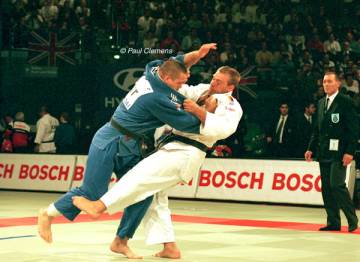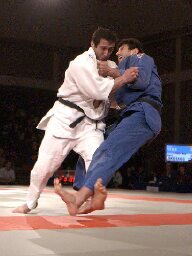by Elie A. Morrell, ShichidanINTRODUCTION
Many beginning students usually have a more difficult time learning to accomplish a gari leg action correctly than they do at learning the gake leg action.The most common error associated with attempts to execute a gari leg action is that whereby the student plants the foot on the mat and in fact does no part of the gari leg action! What usually follows this error is one of two things. The student either attempts to push the uke down to the mat or tries to pull uke’s attack leg back. The gake leg action seems to be simpler to understand and physically execute by beginning students. As long as the leg is properly is properly placed by the attacker, the major portion of the throw is dependent on the use of the hands/arms used in conjunction with the upper part of the attacker’s body. DEFINITIONS Gake: Gake is a derivative of the Japanese verb ‘Kakeru’ which means to hook, block or hang on to. For throws utilizing a gake action the intent of the attacker is to freeze the defender’s leg in place so that it cannot move thus enabling the attacker to drive the defender back over the immobilized leg. Gari or Kari: Literally means to reap as cutting with a sickle, a scythe or a reaping machine. Students who are first introduced to throws utilizing a gari leg action should have that part of the throw very carefully explained followed by a demonstration of how the attacking leg is used in the throwing technique in question. A suggested approach to explaining the reaping action to the student should include a description of the reaping movement involved when an individual uses a scythe or a sickle to cut tall grass. The key point in the description is to show that the sickle or scythe is NOT placed next to the grass to be cut but some distance away and then swung in a circular arc thus impacting and shearing the grass. The above simple explanation of the reaping action will help the student tremendously in understanding that the attacking leg in a gari leg action is NOT simply placed against the defender’s leg to be pushed away but is at some distance away from the leg that is to be reaped. This simple analogy used by the coach can help tremendously in overcoming the perennial problem of students placing the attacking leg against the leg of the defender. VARIATIONS IN PERFORMANCE OF GAKE LEG ACTIONS As stated earlier, gake means to block or hook. Many judo practitioners perform gake leg actions in a couple of different ways. One method is to block/hook the leg of the defender by trapping it in place followed by pushing or pulling the defender over the trapped leg. Yoko gake is an example of pulling the defender over the trapped leg. A frontal attack of Ko soto gake is an example of pushing the defender over the trapped leg. A second method of applying the gake leg action in Yoko gake and Ko soto gake is to push away the leg for Yoko gake and lift the leg for Ko soto gake. Some high ranking judo authors call these a reaping action at the culmination of the throw. This cannot be the case since the definition of a reap is violated! It is feasible to push or pull the attacked leg to complete the technique, but designating the action as a reap is erroneous.The attacking leg has already been put in place and thus a gari leg action cannot occur since there is zero space between the attacker’s leg and the defender’s leg. Momentum is required by the attacker’s leg when it strikes the defender’s leg in a reaping action. THROWS USING GAKE LEG ACTIONS NOT RECOGNIZED BY THE KODOKAN
Although the above three throwing techniques are not recognized by the Kodokan, if properly executed in judo competition ,an appropriate score would be awarded. Kawazu Gake is worthy of mention here. It IS a recognized judo throw by the Kodokan but is prohibited in judo competition due to the inherent danger of injury to the opponent when properly applied. This article has, by design omitted any discussion of the Barai leg action (Sweeping). However, it is one of the three leg actions, including the two covered in this paper that is very often misunderstood. It behooves judo players to thoroughly study and understand the differences between the three physical leg actions by recognizing them in practice and addressing them by their correct names.
|

 In the ashi waza group of throws beginning students very often have found it difficult to physically differentiate between gake and gari leg actions. This is particularly true for younger students of judo and to some extent for students with limited to extensive experience.
In the ashi waza group of throws beginning students very often have found it difficult to physically differentiate between gake and gari leg actions. This is particularly true for younger students of judo and to some extent for students with limited to extensive experience. The following leg throws which are blocking/hooking techniques are not officially recognized by the Kodokan:
The following leg throws which are blocking/hooking techniques are not officially recognized by the Kodokan: